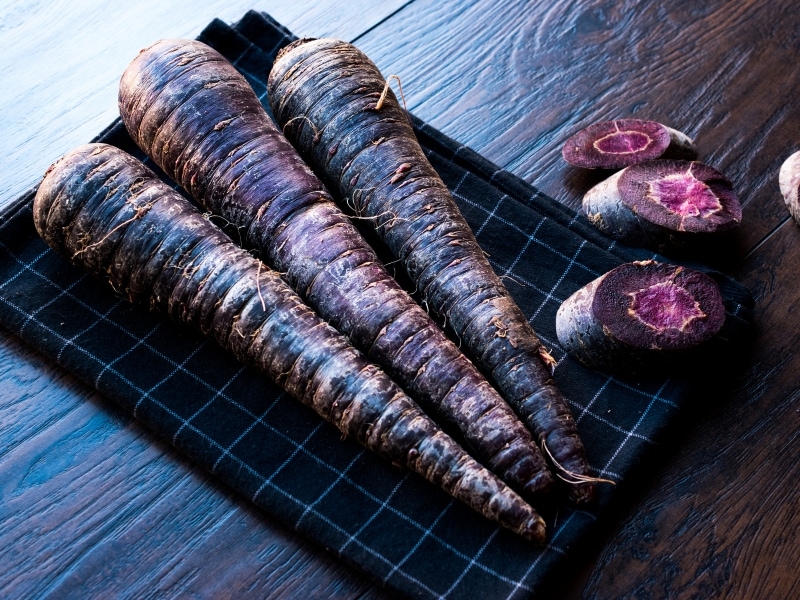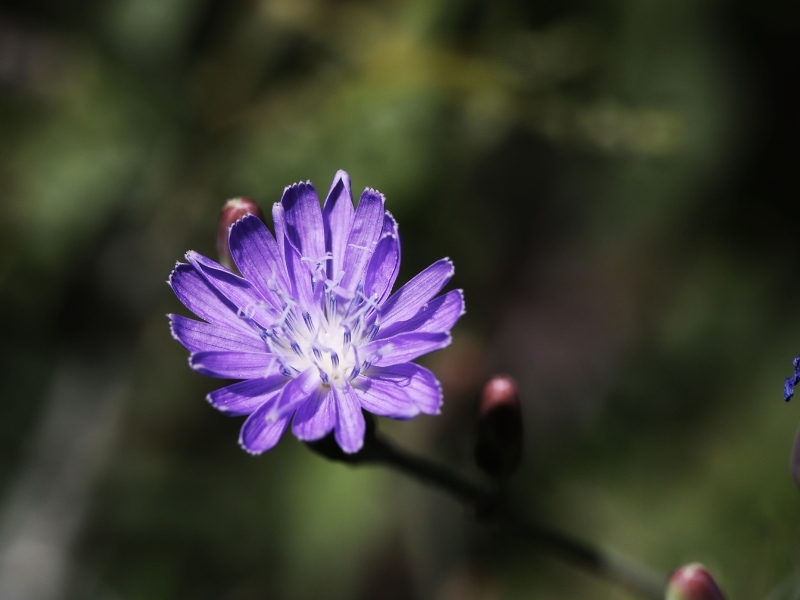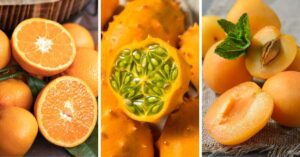Add some natural color to your plate with these fun, wholesome, and vibrant blue vegetables.
From potatoes to corn, they’re easy swaps the kids will love.

Blue vegetables are pretty rare and aren’t always sold commercially.
But if you’re lucky enough to find some, I highly suggest taking some home. I mean, who doesn’t want blue fries with a side of blue, buttery corn?
This list includes everything from leafy veggies to beans. And I think you’ll be surprised how many blue vegetables there actually are.
15 Healthy Blue Vegetables to Put on Your Table

1. Blue Cabbage
Blue cabbage is often confused with red or purple cabbage. But it’s an entirely different variety of cabbage.
As the name suggests, blue cabbage has a unique and distinct greenish-blue color.
The outer leaves are usually more prominently colored than the newest leaves towards the middle.
This cabbage also goes by other names such as ‘blue vantage’ and ‘blue lagoon’.
If you find any variety, don’t hesitate to take it home. The leaves are thick, crunchy, and just as delicious as any.
Use blue cabbage for a colorful slaw or stuffed cabbage, and everyone will want seconds.

2. Blue Milk Mushroom
These vibrant fungi may look like something out of a fairy tale, but they commonly grow in North America, as well as Eastern Asia and Central America.
Also known as the ‘indigo milk cap’ or ‘indigo milky’, the color tends to be more vibrant in younger mushrooms than in older ones, which are more of a grey-blue.
When the flesh of a blue milk mushroom is cut or broken, milk or latex oozes out. This is also an indigo-blue color and can be used to add color to sauces.
Use the blue milk mushroom as you would any other mushroom, including in soups, casseroles, sauces, and more!

3. Filius Blue Pepper
The filius blue pepper is a tiny chili that packs a lot of heat.
These brightly colored peppers are native to North America and are similar to poblanos or chili peppers.
The plant itself has bluish leaves and white blossoms, making it quite attractive. In fact, it would make a great container plant to grow at home.
Filius blue peppers rate around 40,000 to 50,000 on the Scoville heat index. This is about 8-20 times hotter than a jalepeño.
Aside from heat, these peppers also add richness to your dishes. Add them to homemade salsa, tacos, sandwiches, and more.

4. Salad Blue Potato
Salad blue potatoes have highly pigmented flesh and are commonly found in the U.S.
However, they were originally only found in South America.
These potatoes don’t really differ in flavor from a common white potato. However, they do contain lots of antioxidants.
The blue color of these spuds is a result of anthocyanins, water-soluble pigments found in many of these blue vegetables.
You’ll find salad blues in stores as ‘magic molly’, ‘blue tomcat’, and ‘all blue’ potatoes.
Use them as you would any other potato, be it potato salad, mash, fries, or in casseroles.

5. Blue Pumpkins
Blue pumpkins are not as common as other pumpkin varieties. However, they certainly are gorgeous and make fantastic food or decorations.
The ‘Jarrahdale Pumpkin’ and the ‘Queensland Blue Pumpkin’ are the two most common varieties. And as the names suggest, they’re native to Australia.
The shape of blue pumpkins is similar to a common orange pumpkin with some minor differences.
Of course, the main distinguishing feature is the blue-grey hue.
Blue pumpkins have a similar flavor to classic pumpkins, so use them in your favorite pumpkin pie or pumpkin bread recipes.
They’re especially great for pies if you don’t want an overwhelming sweetness.
Otherwise, you can use blue pumpkins as unique fall decor.

6. Blue Corn
Blue corn features dark-colored kernels, and it’s most often found in Mexico and the Southwest and Southeast United States.
Like other blue foods, anthocyanins give it the blue coloring. This also means that blue corn is high in antioxidants, which is a nice bonus!
Ancient cultivators of blue corn were all propagated by Hopi Native Americans and other Southwestern American tribes.
It’s one of the main types of maize used for tlacoyo, a traditional Mexican dish.
You can also use blue corn to make tortilla chips or add it to salads, soups, and more!

7. Fahrenheit Blue Tomatoes
Fahrenheit blue tomatoes are a type of cherry tomato with a bright crimson flesh and dark indigo skin.
They get so dark, they’re almost black!
As you would expect from a tomato with such incredible colors, these have an intense flavor.
And even the aroma of blue cherry tomatoes is rather complex.
Similar to most tomato varieties, Fahrenheit blues are great for heart health and blood pressure. They have tons of anti-inflammatory properties, too.
Eat these small tomatoes fresh or cook them in sauces. No matter how you prepare them, you’re sure to be impressed by these pigmented cherries.

8. Blue Carrots
Believe it or not, blue carrots used to be more common than orange carrots. So before industrialized agriculture, they were the main harvest.
In fact, orange carrots are actually a result of crossbreeding with blue and yellow carrots.
The skin of blue carrots is a dark black-blue or purple-blue color. But cut into them, and you’ll find a variety of different colors ranging from white to orange.
Blue carrots have a similar flavor to orange carrots, meaning they’re nicely sweet and crunchy.
Use them for any carrot dish you can think of, including carrot cake, soups, stews, and chilies. Yum!

9. Tall Blue Lettuce
Blue lettuce can be found in the eastern parts of the United States and Canada.
It’s also called ‘Lactuca biennis’, has been around for decades, and is known to have medicinal properties.
The roots are often used to prevent hemorrhages, heart disease, and digestive issues.
Young leaves of blue lettuce can be eaten raw or cooked. However, use caution because this plant is a mild narcotic.

10. Nonna Agnes Blue Beans
The Nonna Agnes blue bean is a very rare Italian bean.
They were initially found by a man named Joseph Simcocx. He followed their roots and discovered that they originated in a town called Bernardo.
So, they’re sometimes called the ‘San Bernardo Beans’.
Blue beans are best when used dry. However, they can also be used as a shelling or snap bean.
Nonna Agnes blue beans grow in purple pods that are about six to seven inches long.

11. Blue Bayou Tomato (Navy Blue)
Tomatoes are technically a fruit. However, I included them on this vegetable list because they’re almost always used like a veggie.
Blue bayou tomatoes are also known as ‘Solanum Lycopersicum’, and were originally bred by Tom Wagner of Washington.
They range from deep navy blue to purple and grow on solid stems in North America.
Blue bayou tomatoes have a sweet, fruity flavor and can sometimes be pretty tangy.
Still, you can use them like you would any other tomato. So throw them in salads or stack them on burgers.

12. Vates Blue Curled Kale (Blue green)
Blue kale is extremely common, but did you know it’s been around since the 1700s?
It exists throughout the world but originated in the Mediterranean and Asia Minor.
This variety of kale comes in different colors like green, purple, and of course, blue.
Kale is an everyday superfood, meaning it’s full of vitamins and minerals such as Vitamins A, B9, and C.
It’s also high in antioxidants.
Vates blue curled kale can be used in all sorts of recipes, like soups and salads, and it’s an easy way to add vitamins and leafy vegetables to your diet.

13. Adirondack Blue Potato
Adirondack blue potatoes have a blue flesh, and the skin is tinted blue-purple.
Again, they get their blue color from the presence of anthocyanins.
So they’re also high in polyphenol antioxidants which prevent inflammation and improve memory.
Use blue potatoes for chips, potato salad, fries, and more! It’s a great way to add color to your recipes.

14. Purple Asparagus
Although not technically blue, purple asparagus can sometimes have a blue-purple tint. So I thought they deserved a mention!
The vibrant skin of the asparagus hides a green to creamy white flesh. Together, they’re super pretty in slices.
Purple asparagus is also less fibrous and sweeter than other asparagus varieties. So if you can find it in stores or farmer’s markets, I highly recommend it.
The color of purple asparagus remains bright when served raw. Unfortunately, when it’s cooked, the color will dull.
Serve this beautiful vegetable with lemon and salt or butter and garlic. Yum!

15. Blue Cherry Tomatoes
There are many different types of blue cherry tomatoes, including the Fahrenheit tomatoes above.
Other cultivators include “blue beauties”, “blue cream”, and “indigo chocolate”.
It’s incredible how dark and pigmented blue cherry tomatoes can get. Some of them are even closer to black!
Blue cherry tomatoes are not usually sold commercially but can be found throughout the U.S.
Look for them at your local farmer’s market, and you might get lucky!
The flavor of blue cherry tomatoes is complex and intense. So they make a yummy snack and have a crisp, tender, and juicy bite.
Add blue cherry tomatoes to your next grain bowl, salad, or charcuterie board. You can also add them to any kind of pizza or use them to make salsa.










